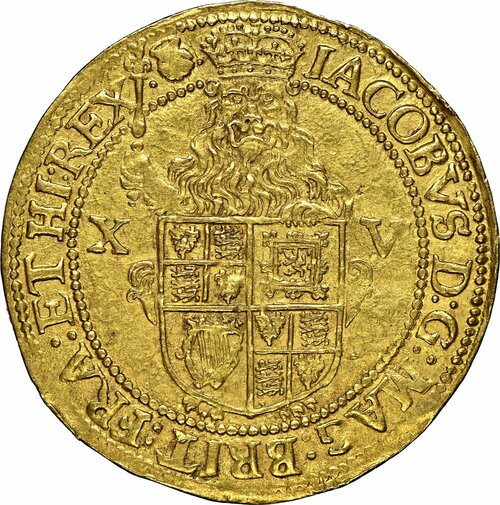Auction: 21064 - The Horace Hird Collection of Tudor, Stuart and Commonwealth Coins and Patterns
Lot: 35
MS62 | James I (1603-1625), Third Coinage, 'Lion' Ryal or Spur Ryal [of 15-Shillings], 1621-1623, Tower, IACOBVS D : G : MAG : BRIT : FRA : ET HI : REX | • (m.m.) • Lion séjant-affronté or 'combatante' holding unified Royal Shield of England and Scotland dividing X-V, rev. (m.m.) A DNO : FACTVM EST [I]STVD ET EST MIRABI :, no stops, except colons after DNO and MIRABI, rose upon radiant sun, alternating crowned Leopards and fleur-de-lys alternating in angles, small pellets in spandrels, 6.25g [96.4grns], 7h, m.m. thistle (HCN 209; Kenyon -; "Unpublished Gold Coins of James I" [1887] -; [1889] -; Devonshire -; Durrant -; Cuff -; Montagu -; Murdoch -; Schneider II 79-80 this m.m. unrepresented; North 2109; Spink 2634), subtly crimped to peripheries, otherwise deceptively bold for strike, a pleasingly good very fine thus, and of the highest rarity with this privy mark, the only example traced in public or private hands, in NGC 'Horace Hird' holder, graded MS62 (Cert. #6135299-035)
Provenance
A Lost Parcel from the Celebrated Horace Hird Collection
H M Lingford, Part II, Glendining, 20-21 June 1951, lot 1052 - 'very fine and excessively rare' - £165.0.0 [Baldwin for Hird]
S G Lyddon, Glendining, November 1937, lot 40
E Rashleigh, Sotheby's, 21 June 1909, lot 859 - fine and very rare, unpublished with this mint mark
H M Grueber, writing for the Numismatic Chronicle in 1907, has advanced the idea that little-known pioneer William Holle was responsible for the drastic redesign of the Jacobean coinage in the final six years of his reign, following his appointment as 'head Sculptor of Irons for the Money' on 29 May 1618. His employment as Cuneator brought to an end the tenure of the Anthony monopoly, the first of whose clan - Dereck is best known for his attractive Pattern Sixpence and Threepence strikings for 1574 and 1575, as well as the majestic bejewelled portraiture adopted for the Sixth and Seventh issues of Elizabeth I.
Indeed, Farquhar (1908) writing in response to Grueber's paper, appended a warrant of 30 December 1619: 'For the Warders of the Mint to make reasonable allowance to John Holle, Engraver of the Mint for Patterns made by him of the King's gold moneys, &c, and for the labours of other gravers and workers employed by him.".
Curiously however, both the christian name and indeed Holle's title in omitting 'Chief', differ from William's authorised standing at the Mint. Nevertheless Grueber's proposition remains outwardly attractive. Holle is known to have been the first engraver of music on copper-plate in England, as well as the talented author of notable illustrations of the period, including but not limited to Martin Billingsley's The Pen's Excellencie (1617) and Michael Drayton's Poly-Olbion (1612, 1622) in which most significantly his rendering of Henry, Prince of Wales and a laureate Drayton himself appear.
The stylistic similarities between the distinct 'third coinage' and these renderings are obvious. Indeed, no official portraiture depicting James I wearing a laurel wreath survives, but it is evident how this contemporary line engraving alongside the wider usage of Roman apparel upon the contemporary issues of Holy Roman Emperors Rudolf II and Matthias could have served as a canon for the re-design. Similarly a prototype for the Lion séjant-affronté can be sourced from the heraldry of leading nobleman, including in the cognizance of John Maitland, 1st Earl of Lauderdale, later President of the Scottish Parliament during the English Civil War.
Nevertheless, the significance of the King's portraiture reversing from facing to the right prior to 1619, to now facing left for the remainder of his reign is frustratingly lacking in scholarly debate, despite it being perhaps the most overt aspect of the redesign. Farquhar did attempt an explanation for the varied nature of the King's visage on the new 20-Shilling coin and its fractions, proposing that Holle must only have responsible for the new Rose and Spur Ryals and Angels on account of his death in September 1624, whilst subordinate 'gravers' worked on the new Laurels, stylistic details of which would extend into the reign of Charles I.
This leaves only a purely practical explanation for this artistic 'volte face'. The retarrifing of all gold specie on 23 November 1611 rendered the Ship Ryal commoditised at 16 Shillings and Sixpence (as witnessed in the previous lot); a hopelessly inconvenient value in general commerce.
The proclamation of 31 July 1619 sought to address this issue, with a total redesign ensuring that there could be no confusion between the old and new coinage (compare lots 18 and 20), especially as both were still expected to circulate together. Furthermore marks of value across the coinage to illustrate the new standards. As William Camden noted, as soon as the new coinage entered circulation on 3 September of that year, they 'got the name of laurels among the vulgar.'
With the death of William Holle recorded in the state papers for September 1624, the responsibility for engraving the King's coinage would fall to John Gilbert and Edward Green, both of whom operated into the reign of Charles I, and whose subsequent work is the subject of further discussion in the postscript for lot 52.
Subject to 20% VAT on Buyer’s Premium. For more information please view Terms and Conditions for Buyers.
Sold for
£52,000
Starting price
£15000













